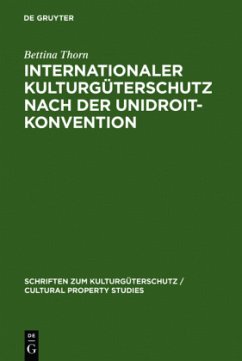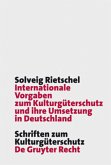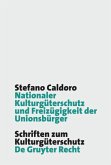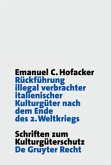Due to their uniqueness cultural assets require a particular protection which must not only be implemented through financial and actual resources but also through the legal process. This work presents the possibility of legal protection of cultural assets using the UNIDROIT Convention on stolen or unlawfully executed cultural assets of 24.06.1995. The passing of this Convention was a milestone on the route to solving the problems of illegal trade in cultural assets.
The work is divided into three main areas. First of all there is an overview of the legal framework of cultural asset protection from international treaties and European legal acts. This is followed by an individual analysis of the regulations of the UNIDROIT Convention and then by a comparison of the convention and national legal regulations in selected European countries and a voluntary code of practice in which there is a detailed section on cultural asset protection in Germany.
Therefore this work shows that an effective cultural asset protection requires the cooperation of states and cultural institutions which must be supported through international regulations and national legislation. The ratification of the UNIDROIT Convention has also proven to be extremely desirable especially as the review possibilities of the Convention text relating to the establishment of an international register of stolen cultural assets and a general obligatory registration for thefts of significant cultural assets have been discussed.
Kulturgüter bedürfen auf Grund ihrer Einmaligkeit eines besonderen Schutzes, der nicht allein mit finanziellen und tatsächlichen Mitteln, sondern auch auf rechtlicher Ebene durchgesetzt werden muss. Die vorliegende Arbeit stellt die Möglichkeiten des rechtlichen Schutzes von Kulturgütern anhand der UNIDROIT-Konvention über gestohlene oder rechtswidrig ausgeführte Kulturgüter vom 24. 06. 1995 dar, deren Verabschiedung einen Meilenstein auf dem Weg zur Lösung des Problems des illegalen Handels mit Kulturgütern bildet.
Die Arbeit gliedert sich in drei Hauptteile: Zunächst erfolgt eine Gesamtschau des rechtlichen Rahmens des Kulturgüterschutzes aus völkerrechtlichen Verträgen und europäischen Rechtsakten. Es folgt die Einzelanalyse der Regelungen der UNIDROIT-Konvention. Daran schließt sich eine Gegenüberstellung der Konvention und nationaler gesetzlicher Bestimmungen in ausgewählten europäischen Ländern und freiwilliger Verhaltenskodizes an, wobei ein Schwerpunkt auf demKulturgüterschutz in Deutschland liegt.
So zeigt die vorliegende Arbeit auf, dass ein wirksamer Kulturgüterschutz die Zusammenarbeit der Staaten und der kulturellen Einrichtungen, welche durch völkerrechtliche Regelungen und nationale Gesetzgebung abgestützt werden muss, erfordert. Die Ratifizierung der UNIDROIT-Konvention erweist sich demnach als äußerst wünschenswert, wobei aber auch Revisionsmöglichkeiten des Konventionstextes hinsichtlich der Einrichtung eines internationalen Registers gestohlener Kulturgüter und einer allgemeinen Meldepflicht für Diebstähle bedeutender Kulturgüter erörtert werden.
Hinweis: Dieser Artikel kann nur an eine deutsche Lieferadresse ausgeliefert werden.
The work is divided into three main areas. First of all there is an overview of the legal framework of cultural asset protection from international treaties and European legal acts. This is followed by an individual analysis of the regulations of the UNIDROIT Convention and then by a comparison of the convention and national legal regulations in selected European countries and a voluntary code of practice in which there is a detailed section on cultural asset protection in Germany.
Therefore this work shows that an effective cultural asset protection requires the cooperation of states and cultural institutions which must be supported through international regulations and national legislation. The ratification of the UNIDROIT Convention has also proven to be extremely desirable especially as the review possibilities of the Convention text relating to the establishment of an international register of stolen cultural assets and a general obligatory registration for thefts of significant cultural assets have been discussed.
Kulturgüter bedürfen auf Grund ihrer Einmaligkeit eines besonderen Schutzes, der nicht allein mit finanziellen und tatsächlichen Mitteln, sondern auch auf rechtlicher Ebene durchgesetzt werden muss. Die vorliegende Arbeit stellt die Möglichkeiten des rechtlichen Schutzes von Kulturgütern anhand der UNIDROIT-Konvention über gestohlene oder rechtswidrig ausgeführte Kulturgüter vom 24. 06. 1995 dar, deren Verabschiedung einen Meilenstein auf dem Weg zur Lösung des Problems des illegalen Handels mit Kulturgütern bildet.
Die Arbeit gliedert sich in drei Hauptteile: Zunächst erfolgt eine Gesamtschau des rechtlichen Rahmens des Kulturgüterschutzes aus völkerrechtlichen Verträgen und europäischen Rechtsakten. Es folgt die Einzelanalyse der Regelungen der UNIDROIT-Konvention. Daran schließt sich eine Gegenüberstellung der Konvention und nationaler gesetzlicher Bestimmungen in ausgewählten europäischen Ländern und freiwilliger Verhaltenskodizes an, wobei ein Schwerpunkt auf demKulturgüterschutz in Deutschland liegt.
So zeigt die vorliegende Arbeit auf, dass ein wirksamer Kulturgüterschutz die Zusammenarbeit der Staaten und der kulturellen Einrichtungen, welche durch völkerrechtliche Regelungen und nationale Gesetzgebung abgestützt werden muss, erfordert. Die Ratifizierung der UNIDROIT-Konvention erweist sich demnach als äußerst wünschenswert, wobei aber auch Revisionsmöglichkeiten des Konventionstextes hinsichtlich der Einrichtung eines internationalen Registers gestohlener Kulturgüter und einer allgemeinen Meldepflicht für Diebstähle bedeutender Kulturgüter erörtert werden.
Hinweis: Dieser Artikel kann nur an eine deutsche Lieferadresse ausgeliefert werden.








